Geysir geothermal area is one of the three top tourist destinations along the Golden Circle in Iceland. The geothermal area where Geysir is located, is in the southwest of Iceland, in Haukadalur valley. The most famous geothermal features of Haukadalur Valley are the dormant geyser Geysir, the geyser Strokkur and the hot spring Blesi.
In this Geothermal Area, you can find the best-known geyser in the world, Geysir. The Geysir – also called the Great Geysir – is responsible for the naming of the other spouting hot springs: geysers. Geysir is derived from the verb gjósa, meaning “to erupt” in Icelandic.
A visit to the Geysir basin is mostly combined with a visit to the mighty Gullfoss. Just 10 minutes away from Geysir, you can find this majestic waterfall!
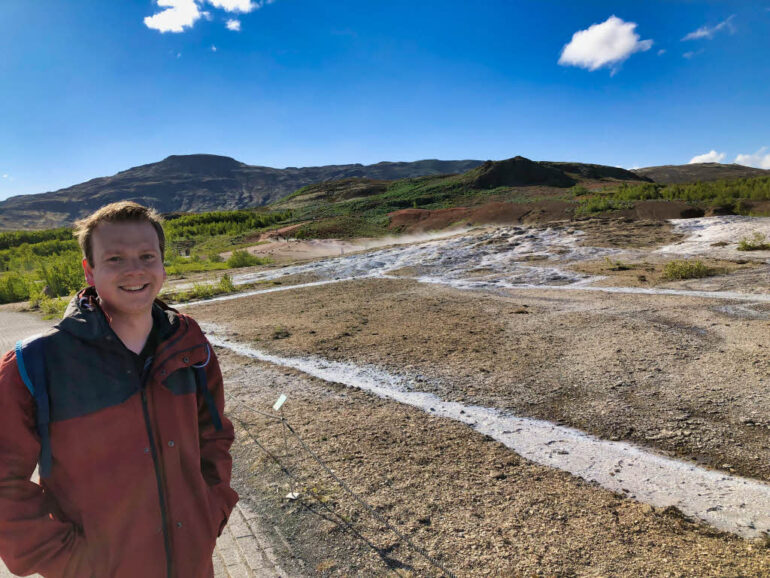
The Great Geysir Iceland
The most famous geyser in Iceland has got to be the Great Geysir. It is the greatest active geyser in the Haukadalur valley, but it is in a dormant state now. That means that there can be years between eruptions. If the Geysir does erupt, the water would shoot up in the air as high as 70 meters (230 feet).
All you can see now is a big bowl. The area around Geysir is completely shut off, so you won’t be able to take a good picture of it.
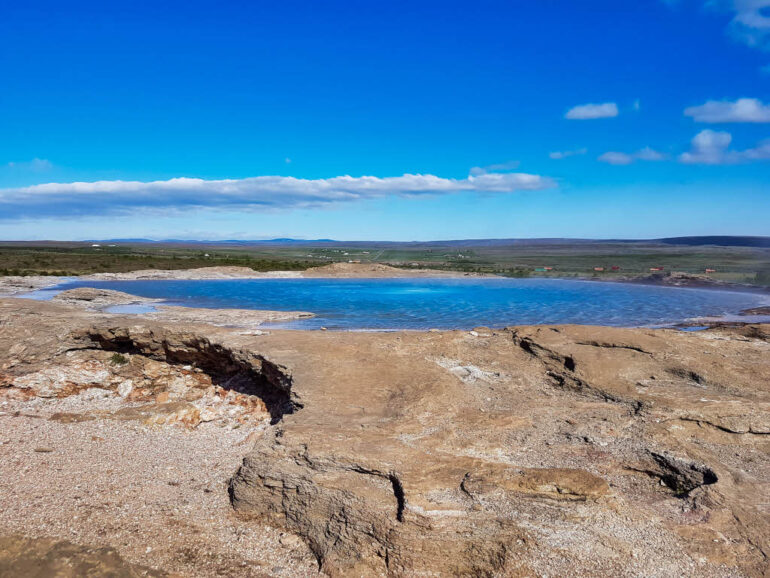
History of The Great Geysir
It’s said that all of the geysers in this area were brought to life by earthquakes a long time ago. Some geysers remained active, while others became inactive over the years.
The Great Geysir had been dormant since 1916. But in 1935, a burrow was made by man in the Geysir and the geyser erupted again until the 1950s. The geyser became dormant again after this because the burrow was filled with sinter now. Preventing it from erupting regularly.
It could erupt from time to time, but it would erupt at very unpredictable times.
In 1981, men enlarged and cleaned the burrow they had created over 45 years ago. This resulted in the Geysir erupting almost every day. However, in 1983 the furrow was dammed and the Geysir went back to its unpredictable state.
Administering soap is normally the perfect way to get some life in the geysers, but with the Great Geysir, you were never certain when it would react to the soap. Sometimes it took hours, days even and sometimes only a few minutes.
The Importance of the Geyser Geysir for Iceland
The Great Geysir had always been important to the Icelanders because the eruption of the geyser had become somewhat of a national symbol of Iceland. Many postcards were created with The Great Geysir on them. Of course, this fame dates back before Yellowstone in the United States was discovered. The glory of Geysir was already established by then.
Although this area has been important to Icelanders for a long time, the area was never a protected area. It has only started to become a protected area since Iceland’s National Day in June 2020! The protected status was long overdue, but luckily it’s in place now. Being a protected area will help with the ensuring of the future of the thermal area and making sure the visits to this area will be safe for both the tourists as the melting pots and geysers.
Strokkur Geyser Iceland
Strokkur is another geyser that can be found in the Haukadalur valley. The geyser Strokkur is slowly kicking Geysir off the throne as the most famous geyser in this valley. Of course, the reason for that is quite simple, Strokkur is a reliable geyser shooting out water and steam every 5 to 10 minutes. Strokkur doesn’t blow out the water as high as the Geysir does, but it’s spectacular nonetheless. The water reaches heights up to 40 meters if you’re lucky.
Strokkur is now the main attraction of the geothermal area. The Strokkur – like the Geysir – threatened to go dormant as well, but the geyser committee decided to prevent this by drilling a hole in the geyser. This was a success and the Strokkur has been sprouting regularly ever since.

Seconds before the Strokkur geyser erupts, it creates a nice bubble of water that you can spot. That bubble will then collapse when the geyser is erupting. We managed to capture a photo of the bubble after staying for 3 eruptions and constantly taking burst photos.
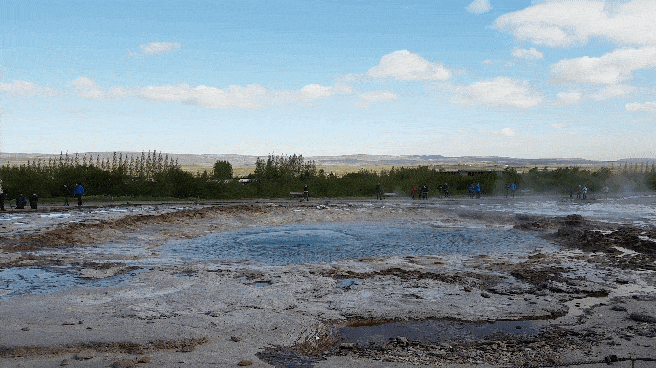
Blesi Hot Spring
Blesi is a hot spring in the Haukadalur geothermal area. It is located above the geysers Geysir and Stokkur. You can find it on the map we attached to our Itinerary of the Geothermal Area below.
Blesi Hot Spring actually exists out of 2 different hot springs that are connected to each other. This makes it look like two blue eyes. Blesi used to bubble and boil but is again dormant now.
The Northern pool has a beautiful blue color. The temperature is only about 40°C in this pool, so you could swim in it. But of course, for health and security reasons, that’s not allowed.
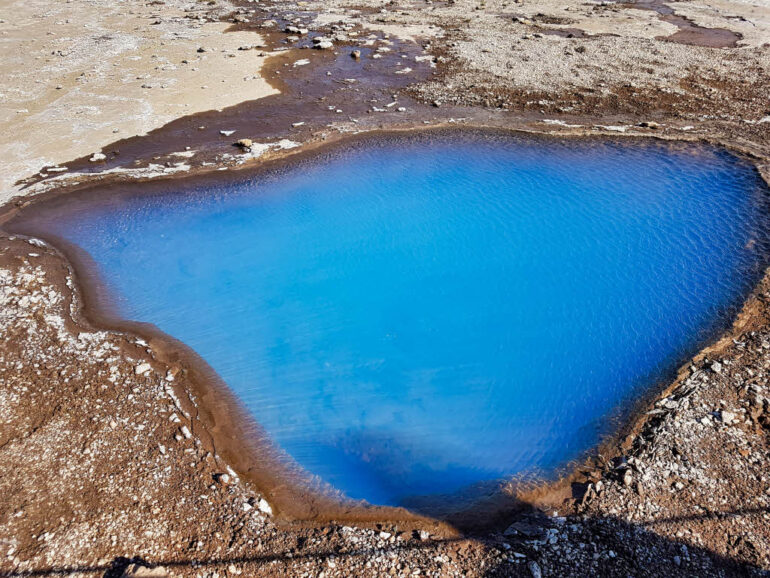
In contradiction to that, the southern pool is very clear and doesn’t have any color. Sometimes it even appears to be dry, that’s how clear and colorless the water is. Because the southern pool is so colorless, you can see with your own eyes where that boiling water originates from.
The water from the southern pool flows to the northern pool heating it up. The Northern pool doesn’t have a source of water, so it’s only getting water from the southern pool.
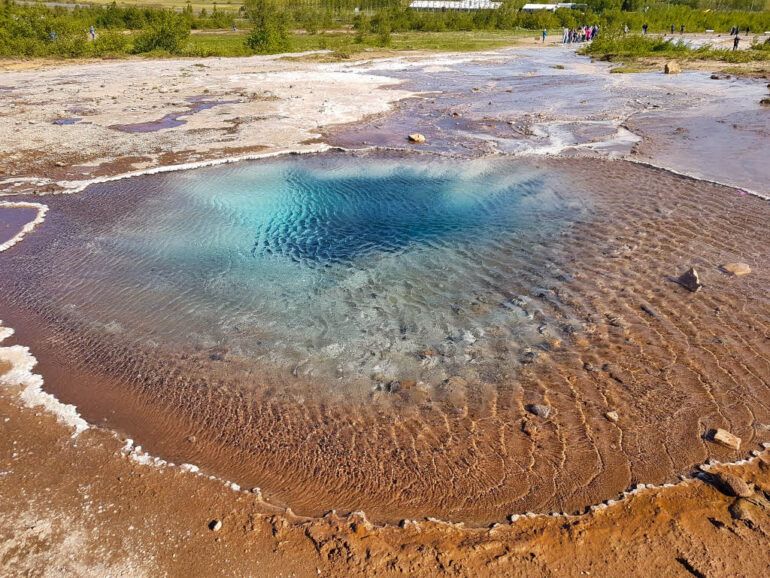
Fumaroles, Hot Springs and Mud Pots
Strokkur, Geysir, and Blesi Hot Spring aren’t the only reason to visit this geothermal area. There are many more awesome things to see in this area. There are fumaroles, hot springs, mud pots, and small geysers all around this area. You can find these on the map we attached below in this post.
Even the ground in between the geysers, is worth looking at. The ground has many colors thanks to the presence of sulfur, copper, and iron. This is what causes the ground to become yellow, green, or red.
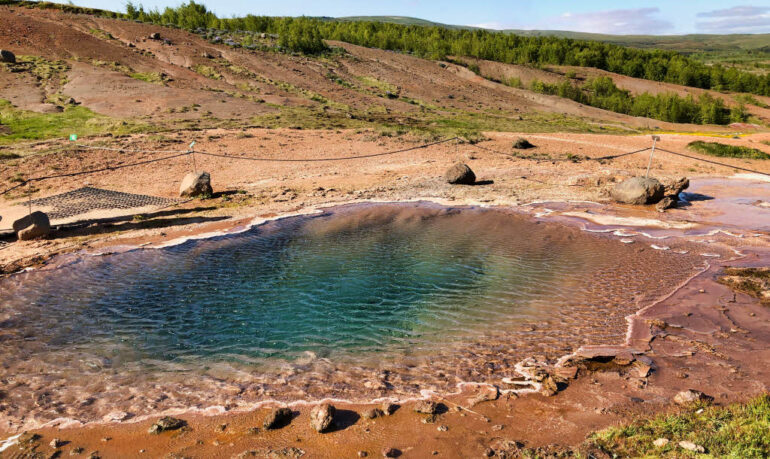
Our Itinerary to Geysir Geothermal Area
We visited the Geysir Geothermal Area near the end of the day. That day we had already hiked in Nesjavellir, visited Kerið, Bruarfoss, and Gullfoss that day. We arrived there at about 4.30 PM. We planned to visit the thermal area before going to dinner.
Our hike started with a view of Geysir. You can’t get close to this hot spring, so we sadly couldn’t take any great pictures of it. We headed to the hot spring Fata and the viewing point nearby (location on Google Maps). The viewpoint was pretty, you have a view over the entire Haukadalur Valley. But of course, most of the time, we were just watching Strokkur to see if we wouldn’t miss an eruption.
After visiting the viewpoint we went to the Strokkur geyser and waited for it to erupt twice. We didn’t manage to take good photos, so we returned to take photos of the Strokkur after dinner. Check out photo tips below for more on that topic.
We continued the path and looked at all the wonders of the area such as Litli Geysir, Konungshver… Some geothermal wonders are difficult to spot since they are a little further away from the walking path, but by all means, never stray from the paths! You could step into a hot stream and burn yourself severely. The geothermal is beautiful, but never without danger. So staying on the pathway is a must!
Tips to Take Great Photos during your Visit to Geysir in Iceland
An important tip we want to give to you is that whenever you’re going to wait on a geyser to erupt, keep the following things in mind:
- In which direction is the wind blowing? (Since you don’t want any hot water on you.)
- Do I have a good view for taking photographs (e.g. sun isn’t right in front of you). You can test this by taking a few pictures out of different angles before the Strokkur is erupting and look for the best light.
- Did I put my camera in burst mode, so I can quickly take multiple photos? (Otherwise you’ll probably miss some parts of the eruption)
- Do I know how often it will erupt? (no use in waiting over an hour if the geyser only erupts once a day…). Now for Strokkur the Geyser is quite frequent, so this one is covered 😉.
- Am I standing too close or too far away to have the best shot possible? (And better to be safe than sorry for this part.)
Well if you’ve answered all of these questions without hesitation, you’re going to have some great pictures!
Our Photos of the geyser Strokkur
We personally wanted to get some nice shots of the bubble that is formed right before the eruption. We had all the time in the world (although we were hungry 😋). Therefore we waited a few times on the eruption to take photos and make a video. It was just too beautiful to walk away. Sadly the sun was making it difficult for us to take a lot of great pictures.
We decided to come back later when the sun had shifted to check if our pictures were better. And they indeed were. The beautiful thing about Iceland is that it hardly gets dark in the summer months, so no need to be there in time to still be able to see something in daylight. But it does get cold though in the evening!
Haukadalur Valley Map
Below you can find a map of the Haukadalur Geothermal area. This is an ideal overview to find all the mud pools, geysers, hot springs, and fumaroles! Whether or not the geysers are active, is also found on this map.
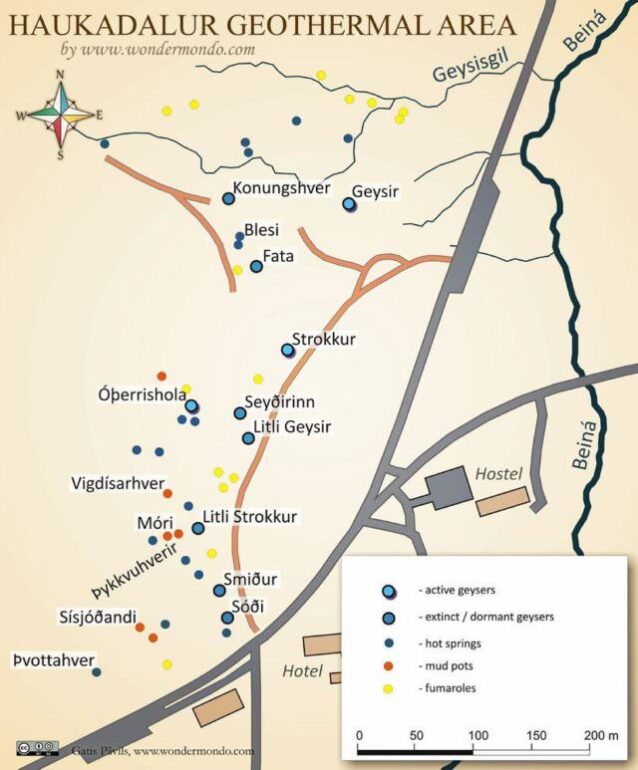
Save Geysir and Strokkur in Iceland for Later
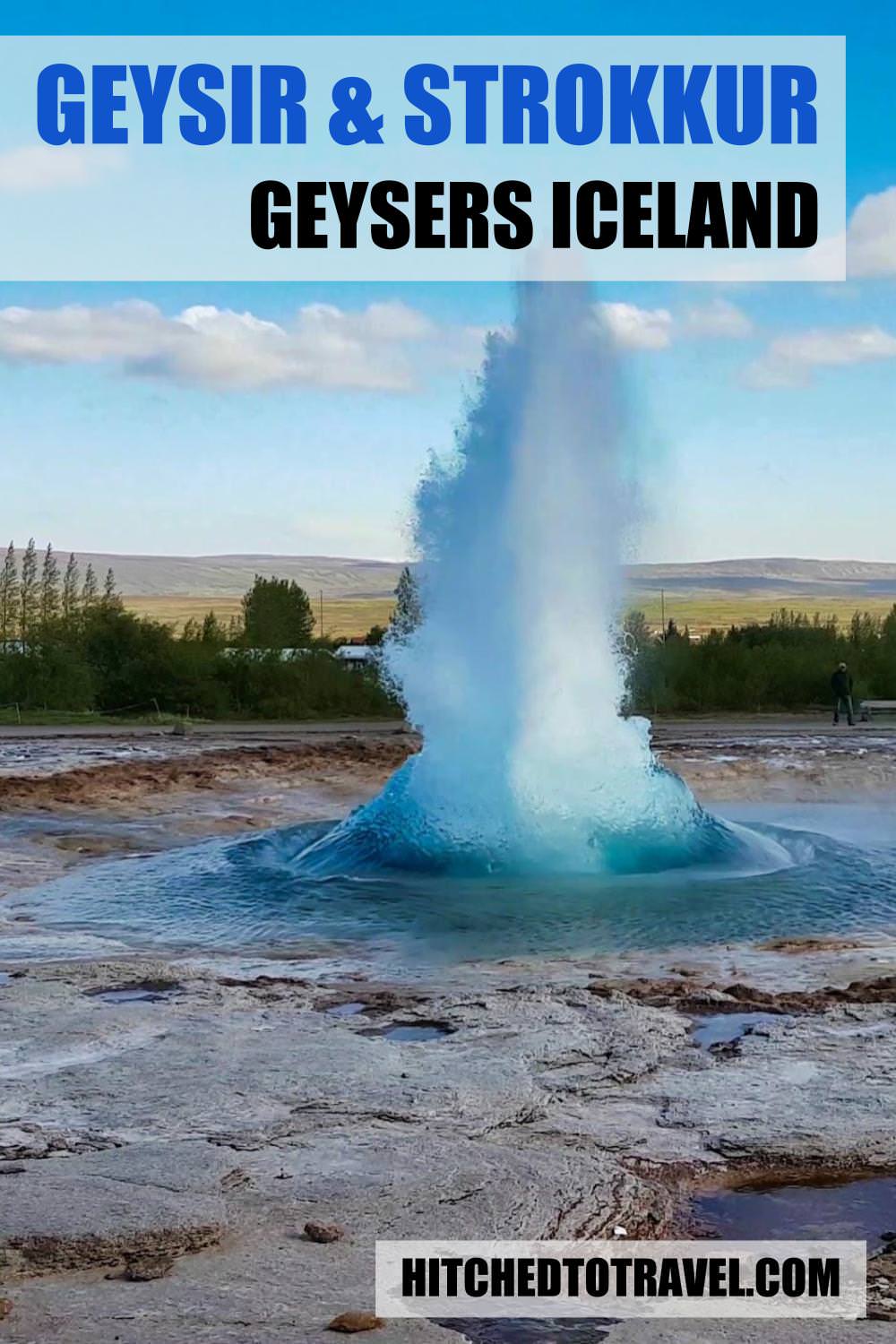


Leave a Reply